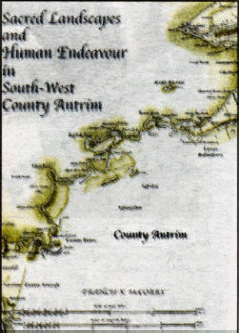
From early Christian churches to thriving 19th century trade
The Digger reviews a new book giving a unique insight into rural Antrim
 YOU might not know it from the weather, but summer has
arrived! The school holidays have started and those who have
spent the past months in planning and preparation for this
busy time can now relax and enjoy the fruits of their
labours.
YOU might not know it from the weather, but summer has
arrived! The school holidays have started and those who have
spent the past months in planning and preparation for this
busy time can now relax and enjoy the fruits of their
labours.
September, however, will be upon us before we can say 'Jack Robinson' and with that in mind, Killultagh Historical Society are now preparing and organising for their next series of meetings and guest speakers.
During the past year members of the Society and visitors to Crumlin Community Centre attended an interesting series of talks at their monthly meetings which covered topics including Denis Wilson's trip from Peking to Paris, archaeological subjects, Lisburn's Castle Gardens area, curios from yesteryear, a history of Killead Parish and a talk on the places and townlands around the shores of Lough Neagh by Dr. Patrick McKay, co-author of a book titled "Lough Neagh Places - their names and origins."
Killultagh Historical Society has amongst their membership a distinguished author of their own -Frank McCorry.
And recently there was an impressive turn-out of people in Lurgan Town Hall for the launch of a new book by Frank titled "Sacred Landscapes and Human Endeavour in South-West County Antrim."
The book offers two quite different insights into the sub-region which embraces part of Lough Neagh's shoreline.
The first part of the book addresses the wonderful array of Early Christian and Medieval church-sites which stretch from Lurgan Rural through Aghagallon, Aghalee and Ballinderry, down to Crumlin and Glenavy. The ruins of some of these early ecclesiastical foundations remain, some indeed continue to be used as parish graveyards.
Donegragh, Knockadoney and Dundesert have disappeared without trace, the latter being an important monastery in which the literature states that seven Egyptian monks lie buried within.
The large, venerable Old Camlin ruin with its unique cluster of large stone sedelia is the tangible evidence of Saint Malachy's reconfiguration of the Diocese of Down in the early part of the 12th century.
In the second part of the book, the economy of the area is examined for the 19th century. During much of this period, farming, linen-weaving, basket-making, fishing and trading combined to provide for many a standard of living which may have been higher than that in neighbouring districts.
The varied landscape and the proximity of Lurgan, Lisburn and Belfast brought about a way-of-life in trading which endures to this day.
In the concluding part of this well-illustrated book, four people with deep roots in southwest Antrim and who achieved notable distinction in life are honoured. They are, Sir John Lavery, international artist, Professor Mary G. McGeown, acclaimed medical specialist, and two former Professors of History in Queen's University, J.C. Beckett and E.R.R. Green.
The book, produced by Inglewood Press, Lurgan, is on sale locally, priced �14.95. Currently a copy of the book can be obtained from Ballinderry China Shop, Costcutters at Aghagallon Post Office, and Easons at Rushmere, Craigavon.
Killultagh Historical Society meets in Crumlin Community Centre on the last Thursday of each month commencing in September.
Visit the Diggers new web site www.glenavyhistory.com
11/07/2008
